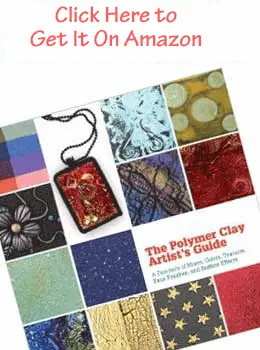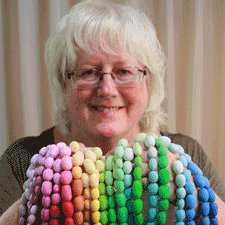Does"The Polymer Clay Artist's Guide"
by Marie Segal Belong In Your Library?
Plus...The Video Interview With Marie and Friends
"The Polymer Clay Artist's Guide" Artist and Author Marie Segal chats about her favorite techniques, textures, surface effects and imitative faux finishes in this directory and who really needs this book with 4 featured artists (including myself). We talked about encaustic wax, combining techniques as well as how to capture those creative ideas, avoid blocks and what's really necessary to live an artist's life.
Read this article. Watch the video below. Have fun and decide if this is a great addition to your library for yourself!
The Video's Guest Artists Agree - This One's a Keeper!
The entire panel agreed that this is a book that over-delivers on its promise. Its an inspirational how-to manual filled with over 100 different techniques and tips. Its gorgeous from the front cover to the back. And it's jammed full of ideas, careful instructions and beautiful example photos that give newbies a jump-start and renew the creativity of even the most jaded clayer.
Then the discussion turned to questions that were submitted from the polymer clay community. In the interest of keeping this page to a managable length, I didn't put everything that was discussed on the Google+ Hangout chat. Watch the video to learn more.
Nancy: There's so many polymer clay books out there. How did you decide on the focus of this one? What was going through your mind when you put this together?
Marie: My mind is usually in pure chaos Nancy. Actually the direction was given to me by the publishing packager, that was Quarto in the UK, in a format that they wanted to see. And I was free to work within that format. It’s been one of the best companies that I’ve worked with in my entire life.
It was really a pleasure to work with these people and my editor, Michelle was just amazing. I have never met a more organized or put together person. And she had never done clay. So I was pretty impressed with the questions she was asking me. And she kept me completely together the whole time. Although I did have one moment of pure panic,
Randee: Just one?
Marie: At other times I got stressed. but it wasn't like I couldn't handle it. I mean it’s not as if I don't know this stuff. I mean experience gets you a lot of places. But having someone that keeps you reined in is very important.
…
Randee: How long did the process take you?
Marie: We started in 2011 with the proposal for 'The Polymer Clay Artist's Guide' and it took until the next year to get it approved and bought by two publishing companies - which are Firefly Books in North America and Searchpress in the UK for Europe. At that point, June or July we started putting things into motion. It was Oct or Nov before we started inviting people in.
I was really interested in publishing people who hadn't been heard of so much. When people saw this book I wanted them to know that there was a huge world of polymer clay people out there. It was almost a mission to bring these people into the forefront and give them a showcase.
…I wanted to give people a body of knowledge, almost like a textbook, that they can work with for a long time. That's why I wanted it to be a book that was almost an encyclopedia of techniques. And there's so much more, but you can only cram so much into 160 pages.
Andrea: You did very well on that one Marie, I have to say it’s amazing.
Marie: I used a crowbar.
…
Randee: I don't think any of us realized how bad we really needed "The Polymer Clay Artist's Guide" until we actually saw it. No one’s ever put them together in such a comprehensive and coherent format. I mean the organization is what just stands out here. It's brilliantly organized.
...
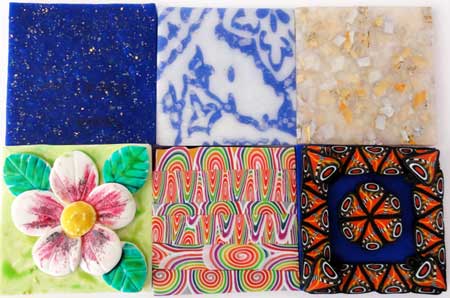
One copy of the book was given away as part of the video chat event. Marie also gave away 6 tiles that illustrated techniques from "The Polymer Clay Artist's Guide". They were, 'candy wrapper in translucent clay', 'delft pottery', lapis lazuli, and the flower is all types of liquid clay painted on the applied clay tile. The one in the middle is all different slices of spiral cane. The one on the other end is 'the space in between cane'. That's cutting apart a shaded cane and putting it back together.
Kelly: What was your favorite technique? How would you use it? And what would you make with it?
Marie: My, that is a good one! Let's see.
You know, this is a very simple technique in the Artist's Guide. Helen Wyland-Malchow, did this piece right here (holds up the book to the camera). Do you see that bowl there? And that's on page 78. I was totally impressed with the way that she handled the base of the vessel.
It was 80 grit sandpaper and basic sanding... She had sanded the surface and it gave it a real nice feel. Lots of things I do in the book I had done before. But then getting pieces and having to fit them into this book, I had to do them again. Or I remember that I had tried that or whatever and then tried some variation on that too. So when I saw that again I thought, oh man, what a beautiful application of sanding.
…The actual tile for this technique is the 'Scratching the Surface' technique which is on page 56. It's the third tile on the right hand side of that page. In "Textured Effects" that is tile number 3.
...

Andrea: How did you happen to meet your first bar of polymer clay (when and how did Marie get bitten by the polymer clay bug?).
Marie: I picked up polymer clay in 1978. I was a ceramic artist and I had seen this woman at the Sawdust Festival in Laguna Beach California who was doing roses and stuff like that. And I was so intrigued with her colors and stuff and I knew that they weren't ceramic. And so I kept searching. I came back to the Sawdust Festival. And if you've been there, well its hard to park even at this place during the summer, and it doesn't matter what day you go. Howard and I went back there like 3 times. And I was like, 'I've got to talk to this lady and find out what this is'. I never met up with her. So thank you, whoever you are for influencing me at that time.
I searched through every craft store for this plastic clay. Nothing. I was walking through the International Toy Store in Orange County, in the mall when I found this colored box of clay. And I thought, "Oooh!" and I turned it over, of course it had kid's stuff all over it. But I'm persistent in things like this. I worked in big time color when I was a ceramic artist and worked in low fired glazes and fired many times to get what I'm doing now in polymer clay.
When I took it home it was as hard as a rock, it was not friendly at all. I started working with it and playing with it and doing simple things like ornaments. I think that polymer clay has this 3 dimensional aspect. I'm a painter. I started oil painting when I was 10. And to have solid color in a malleable format? I couldn't help myself. I was hooked, just hooked.
I looked at my husband then, I had goose bumps running up and down every part of my body and I said "This is the next art medium in the world!" And he just said, "Yes Dear."
I think that I was totally in love with it the minute I touched it, to tell you the truth. For me to go through all the kneading, coming from ceramic clay, you have to be either nuts or in love, right?
...
Randee: I've always looked longingly at encaustic wax. I had no idea until I read 'Artist's Guide' that it could be used with polymer clay.
Marie: I barely scratched the surface with this. I thought that there were more people out there doing it. Because usually when things pop into my head I can Google it and there it is. Doll artists first introduced me to this idea. They would take their sculpts and dip them in encaustic wax which would give you an old fashioned doll. Because they were covered in wax a long time ago. And then one of the companies that I distribute for had the encaustic wax and I fell in love with the smell. It's got linseed oil in it, turpentine and it felt like home for me.
...
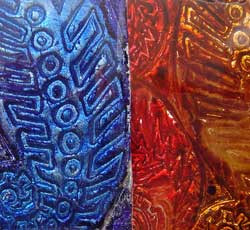
Nancy: What's the most important, foundational technique that you have in "The Polymer Clay Artist's Guide"?
Marie: How to knead your clay. I think that no matter how soft your clay is, it needs to be kneaded completely to redistribute the molecules, the chemicals and everything else in the medium to the point where everything is mixed thoroughly. And when it sits on the shelf it settles, just like everything else does. So I think kneading the clay is important.
Nancy: I've had some people ask me, how long can you let a conditioned sheet of clay sit before you have to condition it again?
Marie: I think that every polymer clay is different. They're similar in chemical formulation, but they're different in personality. And that depends on the clay that you're using. And I think that's important when you're first starting, when you condition the clay. Let it speak to you a little bit. And if you are in tune with what's going on, you will hear it say,"Ok, I've had enough".
Nancy: What does it say when it tells you, "I'm conditioned. I'm happy. Let's work?"
Marie: You can feel it in the material itself because its smooth. And the consistency is nice and "creamy", I like to call it. There are different kinds of clay too, and they feel conditioned, but they need to be worked. So that's another issue also. I'd say, go ahead and hand knead. I like hand kneading. Isn't that silly?
Kelly: Marie, I can see the headline now..."Marie Segal says that Polymer Clay Needs to Be Kneaded!"
Randee: We all need to be needed.
Marie: That's a good one Kelly. A little dramatic though...
...

Nancy: Linda Prais asked "When creating new pieces, where do you draw your inspiration from?"
Marie: Pinterest. Also I look at Design-Seeds.com…They are amazing images and they've taken out color samples from each image on there. It’s like having paint chips taken from pictures. I get a lot of inspiration from that.
Stuff pops into my head a lot. I'll be working on something and I call it going off on a tangent, pretty soon I'm doing something else. And then this, and then this...That happens a lot.
I get a lot of design ideas from dreaming. Waking up in the middle of the night with something saying 'do this'.
Andrea: I hate it when that happens.
Maria: I like it.
Andrea: What I don't like is the insomnia factor.
Marie: I'll give you a little secret about that. Keep a notepad and pen by your bed. When you wake up in the middle of the night, write it down. And then go back to sleep. Because that gets it out of your head onto paper.
…
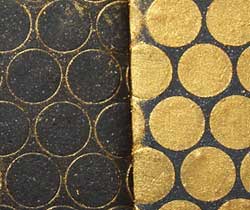
Randee: How much are you influenced by what is directly in front of your table Marie?
Marie: I should show you a picture of my desk. Thank God the camera is set on my face.
I'm influenced by stuff on my desk. I find I walk through a design. When I think of something or pops into my head, or I see a technique and I want to try it my own way, I start to make stuff. And I just keep making stuff. And Howard says, "Come on, just sell it. Please!" So I just start making stuff.
Like when I was making those inked on beads I had well over 100 of them before I was finished writing down the process and was ready to start sharing it.
Marie: That's what this book is about. The part I like best about this artist's guide..was to be able to open up the book and try a technique. And then to go to another page and try that technique. And then to put them together and see what happens. That's how I work.
That's why people freak out in the beginning. They pick up clay and they want to do everything they see. I feel that's overwhelming. That's setting yourself up for failure. It’s what you shouldn't do. Some people can pick it up and just go, you know? But other people get overwhelmed with the tool buying, the clay buying, all the products. You have to have this, you have to have that. And I think that's marketing feeding us 'buy my stuff'. It has to be done, because it's part of the process, but I think it can overwhelm some people who are just starting.
Kelly: You said right there on page 14. "All you need is your hands, a blade and an oven."
Marie: And your heart and your mind. That's all you need to do polymer clay.
Nancy: What's the most important thing for polymer artists to keep in mind when they want to make a living with their art?
Marie: You probably will have to give up a lot of lifestyles and things. Things that you want to buy. And the dream of having a multi-million dollar home. I mean. Let's be serious. The best people in the best places have a husband or spouse that is working so that they can fulfill their dreams. And that hasn't changed since the beginning of time. When artists were working in the Renaissance period I think that they lived with somebody. And they got paid to paint. And they had their food and a place to live.
Nancy: So you hook up with the Medici family...
Marie: And too bad they're dead! Right?
I think that you shouldn't quit your day job to begin with. I think it’s really important to be able to have enough money to buy the product that feeds your creative mind. That's what we did in the beginning. We (my husband Howard and I) did it full time and we lived at poverty level. And sometimes we still do. So you have to be willing to eat a lot of beans and rice sometimes. …This book was a big job. I probably got paid enough to work at Taco Bell for 6 months.
Kelly: You just constantly amaze me with the wealth of knowledge you have. And you just share it. And it’s just amazing. I just love the book.
Marie: Thank you Kelly. I'm going to lay something on you that Michelangelo said, "If you knew how hard I worked to get here, it wouldn't seem so amazing at all." You have to be willing to work hard.
In the beginning, when I started, I had dreams that I wanted to visualize in reality and I couldn't make them come out of my hands. So I'd learn a new technique. Or I'd play with this, or I'd do that experiment. I'd often 'round file' it in the trash can. And then move on to the next thing. And the more I started to know, the better my art got. So that's what I tell beginners. Go out there and learn and do stuff. Make things. Take classes. Read books. Do everything you need to do to help you get the knowledge to do it. I also tell them to keep the beginning pieces, so that they can see how far they've come. That's really important.
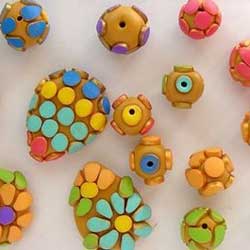
Randee: One of the things that makes this book really unique is that is that it’s a book that artists can grow into. Not out of.
Marie: That just gave me goosebumps, Randee. That was great. Thank you!
Randee: There's a lot of stuff in there that I've never seen before.
Marie: Randee, you've been working in polymer clay since 2005. That's no beginner really in my opinion either. So thank you.
I have always shared with others. I don't feel that I'm in competition with any of you. Any time that I see something that a great artist does in polymer clay or otherwise it gives me a bigger body of knowledge. And that's my concern as an artist. To move forward through that.
I don't get the jealousy and the competition. And every time I play that game I get screwed. I don't understand it. I didn't even understand it as a child with my sisters. I cannot be you. No matter how I try. I don't have your experiences. I don't have your talents. I am not in the same place. So I figure, I might as well go with being me. It works real well for me. And I'm real comfortable with it.
That's the thing with growing old with your art, you get in a place where you're comfortable saying. That's really beautiful and what I do is beautiful too. I'm comfortable with what I do now. It makes me happy.
…
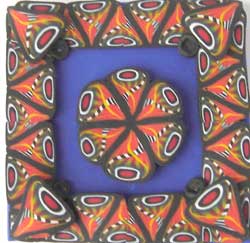
Randee: How important do you think it is for artists to open themselves up to the critique of other artists?
Marie: You need to find something of value in the artwork, no matter what you think about it. So if they've done a really good job of finishing that needs to be pointed out to them. And then I phrase it differently. I say something like, "If I were you I would work a bit more in this area to bring it up to your finishing technique." Nobody likes to be kicked in the face in any way, shape or form. And what we need to realize as artists or people who are working in this, is that we wouldn't like it either.
Bottom line, yes, we appreciate the creative, constructive criticism. But a little under the breath, we could say, "just work on this piece here, just a bit more". Or, "Wow, when I look at this, if the back was done like the front was, wouldn't that be amazing."
…And if you look inside yourself and you know, "I can't take this right now, it will hurt me." Don't ask for critiques.
Randee: There is a Facebook group that offers very kind, well thought out critiques and I've found that to be enormously valuable for myself. They say things like, "I really like how you've done this. Have you ever thought of adding this." You can find it on Facebook (Nancy's note: I think that it's called Critiques - Because feedback isn't always pleasant) But it’s really helped me grow a lot.
...
The Secret to Creativity is Sharing And Finding A Supportive Group
Marie: I heard a lady on tv. She was a multimillionaire. And she said, "Everything I've ever given out has been returned to me tenfold. That was like a big gong going off in my head. Because I was trained in old school art... I was told not to share unless I was teaching. Not to share unless I was making money at it. That's the world that I grew up in.
Nancy: I wonder how much of that whole sharing culture is also due to the relative youthfulness of the medium? And the fact that technological discoveries are being made now, to the medium. I mean, oil paint's been around for centuries now. If you discover something new in oil painting, you're told that you're sitting on a gold mine, don't ever let it go.
Marie: This is how I'm going to explain it. This is another perfect storm here. Where we're at in polymer clay at this point is like the guy putting egg and pigment and wondering if it will stay on the wall or canvas or anything like that. We're in the raw beginning of the medium. And this is how far it’s come in 50 - 60 years.
…I tell you, when I talked to people in the beginning they would say, 'well it's a resin based, blah, blah, blah...' and its low fire. They didn't share at all.
And then there were people that did. In my little group, in the beginning, the people that I was selling to, if I discovered something, I would call them and tell them. And they were doing the same thing, because we had no one else to talk to at that time.
... It took a long time to realize that I was just as entitled as the next guy. And I had something of value to offer people. They could listen or they couldn't. If they didn't like it, it wasn't my problem. So I gather people next to me who feel the same way.
It's an amazing time and we have so much to create. Do we have time to worry about who's watching?
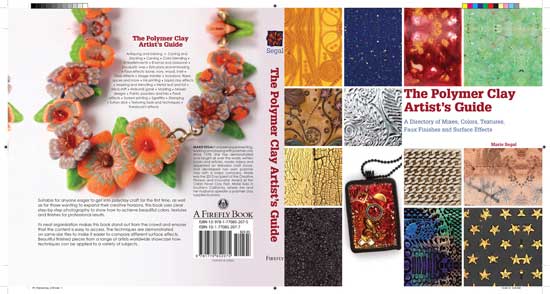
How Do You Do Self Promotion?
Marie: I have a hard time wagging my own tail. I was raised a Catholic. Saying, "Hey, look at me!" You just don't do things like that...It's never gotten me anywhere to be a braggart. I love it when people come up to you and they're jumping up and down because they met you. And then I'm like, "Can I have that on recording so that I can play it when I'm cleaning the toilet or wiping up cat poop and throw-up?"
That's why I'm so very grateful to Andrea and Randee for your reviews. It is so important to Amazon sales to have good reviews.
So, What's Next Marie?
Marie: I intend to live the rest of my life running wild actually and doing what I want to do. And if people are good with that they'll come with me. They'll be with me. And if they're not? Well I just won't know.
So it’s all good. There's a big world out there and there's enough for everybody. There's plenty for everybody.
Featured Guest Artists In The Video Chat

Andrea Paradiso - Andrea is overjoyed because as of this very day, Sept. 8, 2013, a lifelong dream has come true. She has turned her art fantasy into real work and opened her own Etsy store Andrea's Real Fantasy for OOAK Jewelry and Sculpture ... and polymer clay has made it all come true!

Kelly Steindorf - "I have been working with polymer clay for about 17 years now and love the ability to use it with so many different mediums. I love caning, imitating nature and experimenting with bits...to create something wonderful."

Randee M Ketzel lives, breathes, and teaches the exquisite art of polymer clay in Austin, TX. Her work may be viewed at RMKDesign.
And me, Nancy Ulrich. My photo's in the left column and there's entire page about me right here.
Find Out More About Marie Segal

Marie's been working with polymer clay for more than 35 years. She's made a living with her passion through craft fairs, gallery shows, videos, books and the creation of products including one of the major art clays. So watch the video as we pick the brain of a master artist who has done it all.
She's also an excellent, in demand teacher who makes even the most difficult techniques understandable. Take her "Alien Forms" and "Snapshot Beads" classes at the Northwest Polymer Clay Guild's Clay Camp May 16th - 19th in Seattle, Washington.
Web sites
- www.mariesegal.com
- www.clayfactory.net
- www.thehoarderscloset.etsy.com
- www.mariesegal.etsy.com
- www.craftysellers.etsy.com
Blogs
- www.mariesegal.blogspot.com
- www.mariesegal.wordpress.com
Facebook and pages
- www.facebook.com/PolymerClayArtistsGuide
- www.facebook.com/mariesegal1
- www.facebook.com/pages/Marie-Segals-Art-from-my-Heart/191574957520769
- www.facebook.com/pages/Clay-Factory-Inc/256693098390
- www.facebook.com/CraftySellers
- https://www.facebook.com/pages/The-Hoarders-Closet-by-Marie-Segal/105412076200777
|
|
|
What do You think about 'The Polymer Clay Artist's Guide?' Or do you have a question for Marie?
Polymer Clay Home Page › Books! › The Polymer Clay Artist's Guide
